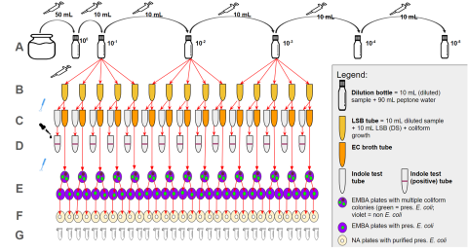VOLUME 17 (Supplement)

SciEnggJ 17 (Supplement) 321-330
available online: July 29, 2024
DOI: https://doi.org/10.54645/202417SupXLS-26
*Corresponding author
Email Address: wlrivera@science.upd.edu.ph
Date received: April 7, 2024
Date revised: June 6, 2024
Date accepted: July 1, 2024
ARTICLE
Fecal coliform assessment and detection of blaTEM, blaSHV, and tetA in Escherichia coli isolated from selected river waters of Tacloban City, Leyte, Philippines
Institute of Biology, College of Science, University of the
Philippines Diliman, Quezon City 1101, Philippines
Fecal coliforms (FCs) are generally used as indicators of fecal pollution in water systems. High levels of FC pollution in water bodies may also be associated with antibiotic resistance. Escherichia coli, a member of the FC group, is generally commensal and harmless. However, some strains can cause various diseases in humans. The prevalence of antibiotic-resistant E. coli has been reported in several river systems worldwide. Herein, we report the most probable number (MPN) of FC and E. coli and the first detection of blaTEM, blaSHV, and i>blaSHVetA antibiotic resistance genes (ARGs) as well as ARG combinations (i.e. blaTEM + tetA and blaSHV + tetA) in E. coli isolates from river waters with high levels of FC in Tacloban City. MPN was determined using a multiple-tube fermentation technique, and ARG was detected using polymerase chain reaction (PCR). Results show that the Bagacay River had the highest MPN of FC and E. coli (both >160,000 MPN/100 mL), followed by the Burayan Creek (>160,000 MPN/100 mL; 160,000 MPN/100 mL), the Mangonbangon River (92,000 MPN/100 mL; 54,000 MPN/100 mL), and the Tigbao River (35,000 MPN/100 mL; 24,000 MPN/100 mL). Among the 113 uidA gene-confirmed E. coli isolates, blaTEM, blaSHV, and tetA were detected in 39 (34.5%), 7 (6.2%), and 83 (73.5%) E. coli isolates, respectively. Moreover, 34 (30%) of the isolates possess both blaTEM and tetA, and five (4.4%) of the isolates have both i>blaSHV and tetA. These results imply that the rivers are unsafe for anthropogenic use and the presence of ARGs in E. coli isolates pose a threat for locals. Hence, the public is urged to ensure safety and awareness in relation to these water environments. Further monitoring and source tracking are recommended to enhance environmental and public health safety among locals.
© 2025 SciEnggJ
Philippine-American Academy of Science and Engineering